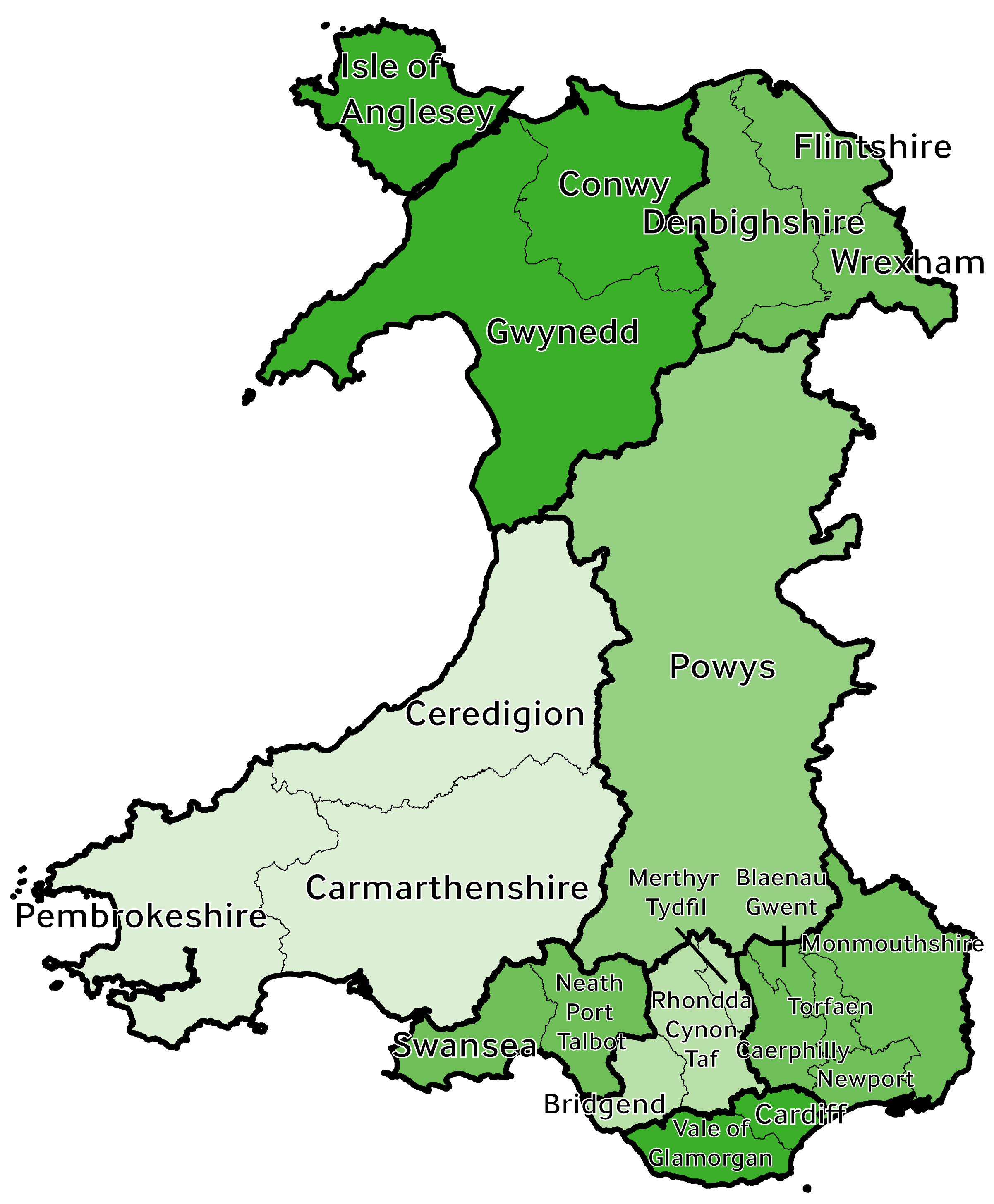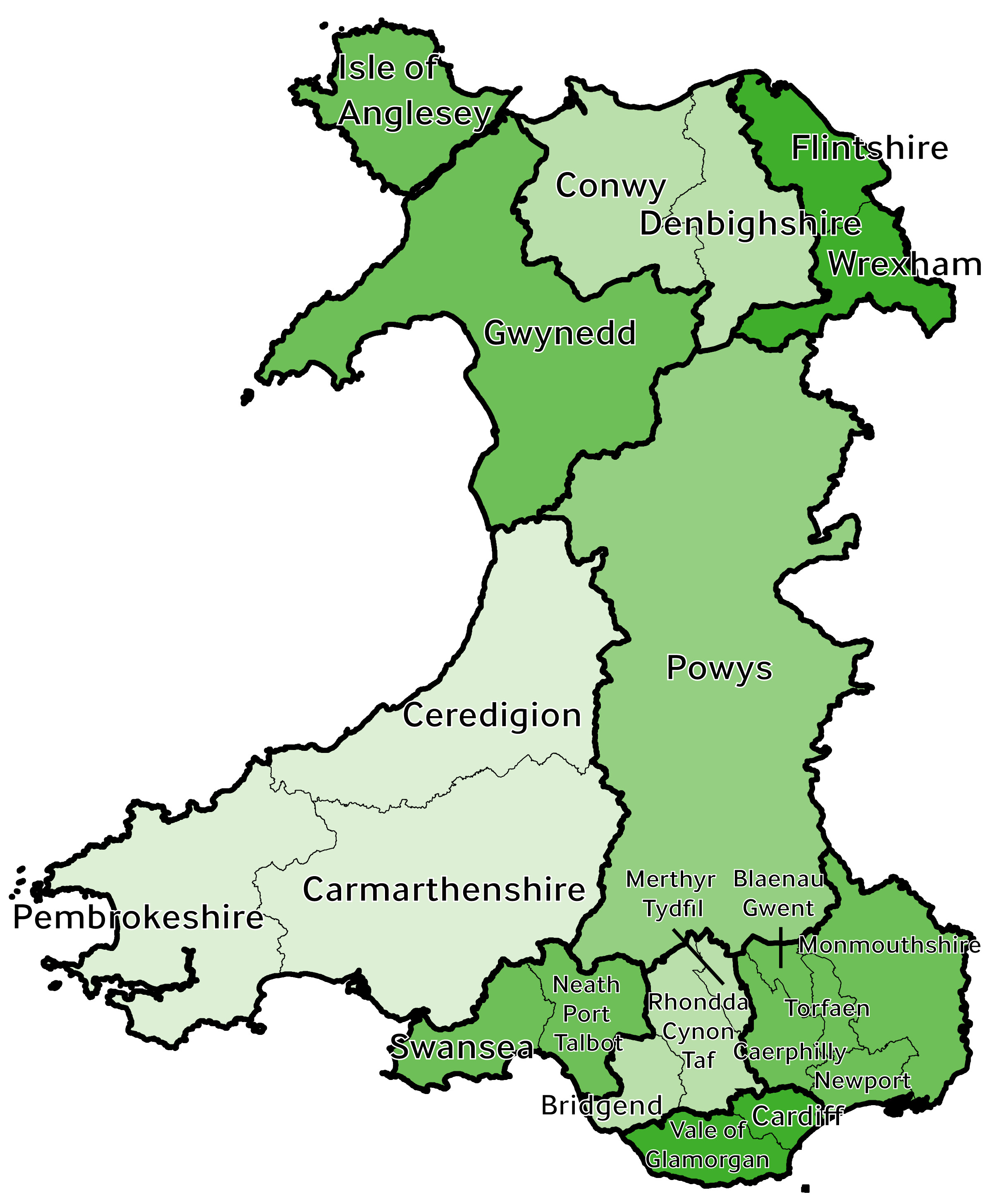Article by Rhys Iorwerth, National Assembly for Wales Research Service
Throughout the Fourth Assembly, there was much debate about restructuring Welsh local government. Will the new Welsh Government finally press ahead with such plans?
Since 1996, Wales has had 22 county or county borough councils (or ‘local authorities’ as they are also often called). As financial pressures mount, politicians have increasingly discussed whether we need them all. They have also debated the best alternative if 22 is too many. Whether we will still have this number by the end of the Fifth Assembly is therefore very much in doubt. [caption id="attachment_6517" align="alignleft" width="248"] How eight authorities could look[/caption] The last Welsh Government’s plans In 2013, the Welsh Government set up the Williams Commission to look across the board at how public services were delivered in Wales. The Commission’s report was wide-ranging, but one of its headline conclusions was that many local authorities were too small to perform effectively. It suggested that the Welsh Government should merge the 22 county and county borough councils to form between 10 and 12 authorities, and to do so ‘swiftly and decisively’. The last Welsh Government initially responded by saying it preferred a 12-authority model. This changed in June 2015 when Leighton Andrews, the then Minister for Public Services, published a map showing the Welsh Government was now in favour of either eight or nine authorities instead. In November 2015 the Welsh Government published the draft Local Government (Wales) Bill. This contained provisions to enable mergers, as well as other major reforms to how Welsh local government works. According to the Minister, ‘severe and unsustainable financial pressures’ on public services meant that ‘inaction [was] not an option’. While the Welsh Government acknowledged that the mergers could cost up to £254 million, it also claimed that they could result in savings of up to £915 million over 10 years, if completed by 2020-21. A consultation on the draft Bill closed in February 2016, and the then Minister announced in March 2016 that he was analysing the responses. After being appointed First Minister in May 2016, Carwyn Jones suggested in media reports that the eight or nine-council model could be difficult to take forward, but that he would continue to seek reform of some kind.
How eight authorities could look[/caption] The last Welsh Government’s plans In 2013, the Welsh Government set up the Williams Commission to look across the board at how public services were delivered in Wales. The Commission’s report was wide-ranging, but one of its headline conclusions was that many local authorities were too small to perform effectively. It suggested that the Welsh Government should merge the 22 county and county borough councils to form between 10 and 12 authorities, and to do so ‘swiftly and decisively’. The last Welsh Government initially responded by saying it preferred a 12-authority model. This changed in June 2015 when Leighton Andrews, the then Minister for Public Services, published a map showing the Welsh Government was now in favour of either eight or nine authorities instead. In November 2015 the Welsh Government published the draft Local Government (Wales) Bill. This contained provisions to enable mergers, as well as other major reforms to how Welsh local government works. According to the Minister, ‘severe and unsustainable financial pressures’ on public services meant that ‘inaction [was] not an option’. While the Welsh Government acknowledged that the mergers could cost up to £254 million, it also claimed that they could result in savings of up to £915 million over 10 years, if completed by 2020-21. A consultation on the draft Bill closed in February 2016, and the then Minister announced in March 2016 that he was analysing the responses. After being appointed First Minister in May 2016, Carwyn Jones suggested in media reports that the eight or nine-council model could be difficult to take forward, but that he would continue to seek reform of some kind.
The response to the merger plans
[caption id="attachment_6518" align="alignright" width="247"] How nine authorities could look[/caption] The Williams Commission recommended merging the 22 authorities along their current boundaries, rather than redrawing the local government map from scratch. The last Welsh Government agreed with this approach, claiming it would achieve the benefits of having larger authorities without the bigger disruption of more fundamental boundary changes. Others, such as the Fourth Assembly’s Communities, Equality and Local Government Committee, claimed that form should follow function. This means that, before restructuring, it is necessary to assess what type of services local government should be delivering in a devolved Wales. The Committee suggested that only then can it be possible to come up with a sensible map and an optimum number of authorities. It also claimed that this would be more sustainable in the long term than simply grouping together the current council blocks.
How nine authorities could look[/caption] The Williams Commission recommended merging the 22 authorities along their current boundaries, rather than redrawing the local government map from scratch. The last Welsh Government agreed with this approach, claiming it would achieve the benefits of having larger authorities without the bigger disruption of more fundamental boundary changes. Others, such as the Fourth Assembly’s Communities, Equality and Local Government Committee, claimed that form should follow function. This means that, before restructuring, it is necessary to assess what type of services local government should be delivering in a devolved Wales. The Committee suggested that only then can it be possible to come up with a sensible map and an optimum number of authorities. It also claimed that this would be more sustainable in the long term than simply grouping together the current council blocks.
Local accountability
Some critics are concerned that having eight or nine large authorities could risk undermining local accountability and the relationship between the councils and the communities they serve. In its draft Bill, the last Welsh Government proposed creating ‘area committees’ to give localities a voice within the larger councils, but there are doubts about how effective this might be. In a 2014 discussion document, the Welsh Local Government Association (WLGA) proposed a different approach. It suggested retaining the 22 authorities to preserve a sense of place and localism, while creating four regional bodies to deliver major services. These regional bodies could be modelled on the combined authorities approach adopted in England, and could allow certain services to be delivered more effectively on a larger scale without impacting on local links. Others have suggested that reforming and empowering community councils – the lowest tier of local government in Wales – could solve issues around localism if there are to be fewer and larger county and county borough councils.
The relationship between central and local government
While structural and geographical issues have often grabbed the headlines, local government itself has called for a more fundamental shift in the relationship between it and the Welsh Government. Devolution has changed the way Wales is governed, so the councils see a need to re-evaluate and redefine local government’s role in delivering services. In its In Defence of Localism document, the WLGA criticised the last Welsh Government for ‘developing a more centralised and assertive approach’ to public services. It suggested that local government should be given more ‘freedom and flexibility to deliver services according to local circumstances’, and there is no doubt that these calls will continue. The new Welsh Government will therefore have major decisions to make on the number and size of our local authorities. But it is also going to face ongoing pressure from the sector for more far-reaching change.
Key sources
- Welsh Government, Draft Local Government (Wales) Bill (2015)
- Welsh Government, Reforming Local Government: Power to Local People White Paper (2015)
- Welsh Government, The Future of Local Government in Wales (2015)
- WLGA, In Defence of Localism (2014)
- WLGA, The Creation of Four Combined Authorities for Wales? (2014)
- WLGA, Localism 2016-21, A Plan for Public Services in Wales 2016-21 (2016)






